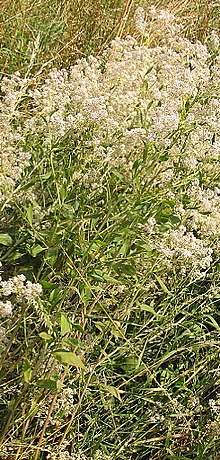Lepidium latifolium
| Lepidium latifolium | |
|---|---|

| |
| Scientific classification | |
| Kingdom: | |
| (unranked): | |
| (unranked): | |
| (unranked): | |
| Order: | |
| Family: | |
| Genus: | |
| Species: | L. latifolium
|
| Binomial name | |
| Lepidium latifolium | |
Lepidium latifolium, known by several common names including Broadleaved Pepperweed, Pepperwort, or Peppergrass,[1] Dittander, Dittany, and Tall Whitetop,[1] is a perennial plant that is a member of the mustard and cabbage family.
This plant is native to southern Europe, Mediterranean countries and Asia as far east as the Himalayas. It is an introduced species in North America, where it grows throughout the United States and Mexico, and Australia. It may have been introduced to the United States when its seed got into a shipment of sugar beet seeds.[2]
L. latifolium normally grows to between 30 centimeters and 1 meter, but may grow as tall as 2 meters. The plants have numerous woody stems, alternating waxy leaves and clusters of small, white flowers. It produces small (1.6 millimeter) fruits which each contain two reddish seeds. It has an extensive root network, known to reach 9 feet in depth and constitute 40% of the total biomass of the plant.[2]
Dried stems of L. latifolium are sometimes used in flower arrangements.
The plant is most invasive in wetland habitat, including riparian zone; from there it easily spreads to other ecosystems, such as sagebrush.[2] It is perceived as a threat to salt marshes in southern New Hampshire, United States, recently prompting the Department of Environmental Services and the U.S. Fish and Wildlife Service to look for it in the Hampton–Seabrook Estuary, where it is thought to have spread. The agencies are recruiting volunteers to help look for and properly remove it from this area.[3] It is also a pest in the Monte Vista and Alamosa National Wildlife Refuges in Colorado and Malheur National Wildlife Refuge in Oregon, and many other sites.[2]
Edible uses
The leaves, shoots, and fruits of this plant are all edible. The leaves are said to have a watercress-like peppery taste which is good for salads. The seed pods are sometimes added to stir-frys.
In Ladakh in the Himalayas, the spring leaves are prized as a vegetable. The peppery edge or bitterness is removed by first boiling the young shoots and leaves, and then soaking in water for two days. Cooked like spinach, it makes a rich and delicious vegetable.
References
- ^ a b USDA Plants Profile
- ^ a b c d US Forest Service Fire Ecology
- ^ "NH looking for volunteers to stop invasive plant". Associated Press. 2008-06-16. Retrieved 2008-06-17.
External links
